Why you can trust TechRadar
At 109.6x62.8x35.7mm the Alpha 5100 is smaller than the A6000 (120x66.9x45.1mm) and slightly smaller than the NEX-5T (110.8x58.8x38.9mm) and this has meant the loss of the control dial on the top of the camera.
As a result the Alpha 5100 makes greater use of the navigation controls and it's a shame that the menu (which is the same as the A6000's) can't be navigated via the touch-screen.
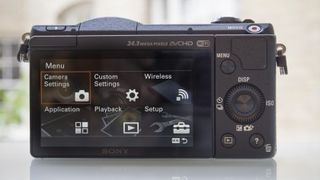
If you want to change the shooting mode (for instance from automatic to one of the semi-automatic modes) then you can go through the main menu. I found it quite useful to set one of the custom buttons to this function though, to give you quicker access.
There's also no hotshoe or viewfinder on the top of the camera, so if you're a fan of composing in a traditional manner you'll be out of luck here.
One of my favourite things about Sony cameras is their level of customisation. Here on the A5100, that extends to the central button in the four-way navigational pad, as well as all of the directional keys around the pad.
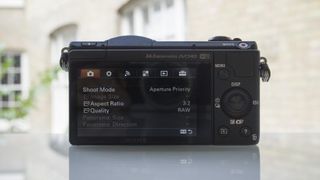
By default, each of these has its own function (such as left for self-timer or down for exposure compensation), but if you'd prefer to change this system then you can. There's also a button marked with a question mark that you can assign a function to. For each custom button there are 35 different options.
Despite its small size and light weight (224g), the A5100 feels solidly made. It feels most suited to use with the 16-50mm f/3.5-5.6 lens in terms of proportions - using it with something large like the Zeiss 16-70 f/4 lens makes it feel slightly unbalanced. There's a decent sized grip which has a textured coating, which makes it feel comfortably secure in the hand.
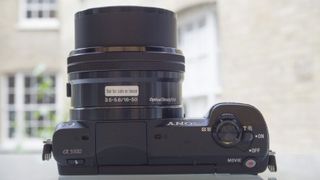
Sony says it has designed the A5100 with one-handed shooting in mind. This is evident by the fact that all of the buttons are grouped on the right hand side of the camera. Around the shutter release, there's a zoom lever, which is useful when using the power zoom lens, as again it means you only need your right hand to operate camera. There is also a switch on the lens itself if you prefer to use both hands.
To start movie recording, you can use a dedicated button on the top of the camera which is set at an angle and helps to avoid accidental knocks. The only button which isn't found on the right hand side of the camera is the flash button - you need to press this to cause the flash to pop up.
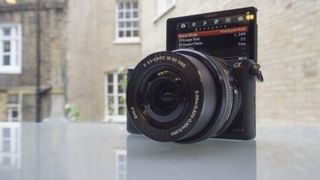
One word of warning when using the flash: if you're using anything other than a short lens, then the flash doesn't raise high enough to clear the lens barrel. The kit lens is fine.
If you're shooting in manual or semi-automatic modes, then you'll need to use the scrolling dial on the back of the camera to alter shutter speed or aperture. While in manual, press the down key to switch between the two parameters.
The addition of a touchscreen makes setting the AF point a much quicker and easier process than on several other Sony cameras, including the A5000. Once you've set the AF mode to Flexible Spot (you can also choose between small, medium and large spot), simply tap the area on the screen you wish to focus on.
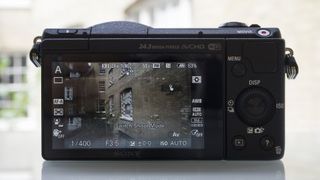
Sony simplified its menu systems across its range of cameras a while back, and here again we find a fairly sensibly arranged menu divided into different tabs. There's still some slightly incongruously labelled options, such as 'audio signals' which allows you to switch off the beep, but it's something you get used to with exploration.
If you have an NFC-enabled device, pairing it with the A5100 is a doddle. Simply tap the two together at the relevant points on both devices and the Sony PlayMemories app will launch automatically if you have it installed - if you don't you will be prompted to download it from the Google Play store.
If you have only a Wi-Fi enabled device (such as an iPhone), then you'll need to connect via Wi-Fi. This is a slightly more laborious process, but once you've connected once it becomes easier.

Remote controlling the camera from the app is useful if you're shooting from a distance, or want to do a group portrait, but it's a shame that you can't control different parameters from the app itself - even more frustrating is knowing that the app is capable of doing this with other cameras such as the QX1.
Amy has been writing about cameras, photography and associated tech since 2009. Amy was once part of the photography testing team for Future Publishing working across TechRadar, Digital Camera, PhotoPlus, N Photo and Photography Week. For her photography, she has won awards and has been exhibited. She often partakes in unusual projects - including one intense year where she used a different camera every single day. Amy is currently the Features Editor at Amateur Photographer magazine, and in her increasingly little spare time works across a number of high-profile publications including Wired, Stuff, Digital Camera World, Expert Reviews, and just a little off-tangent, PetsRadar.


